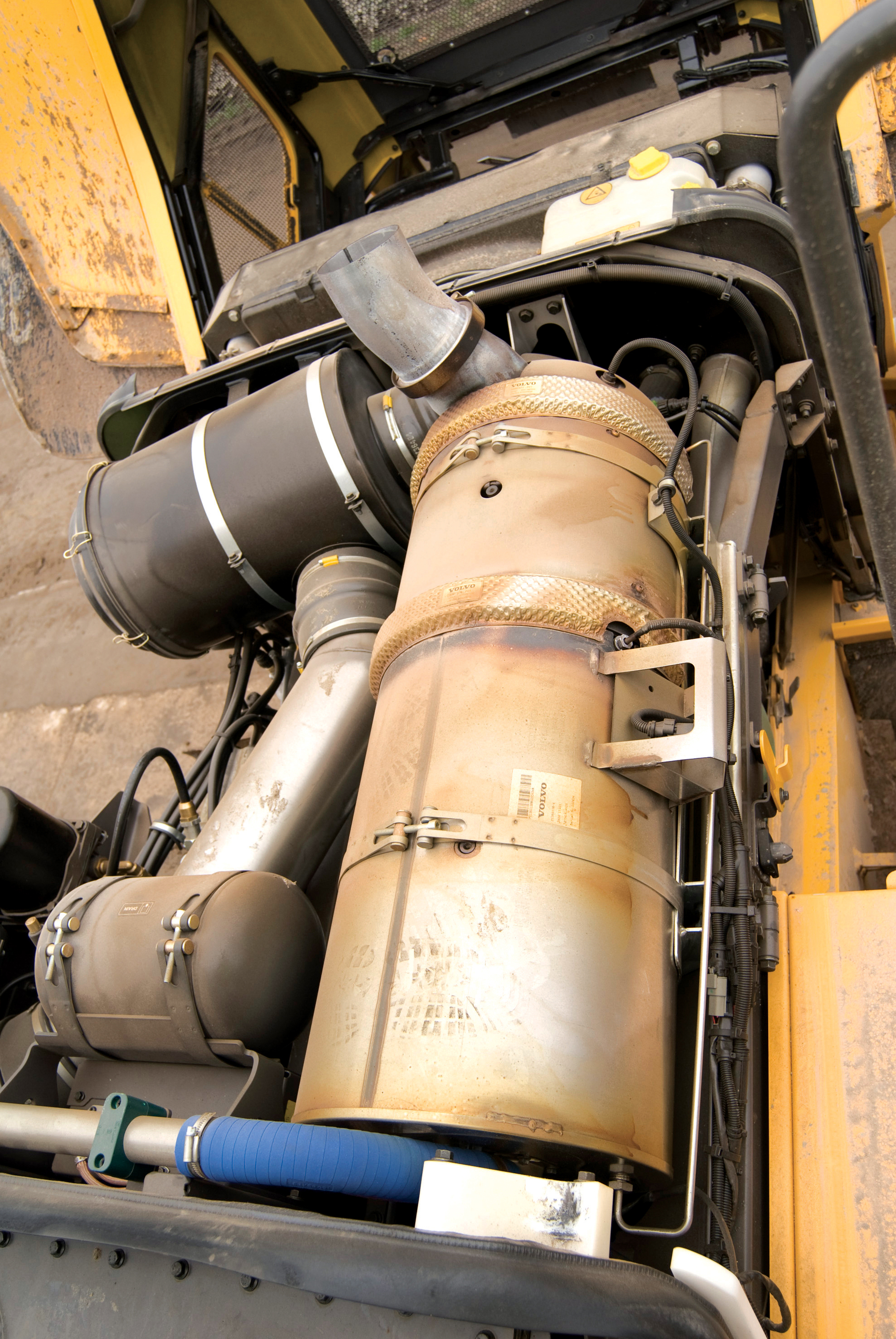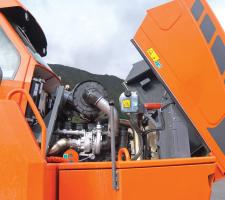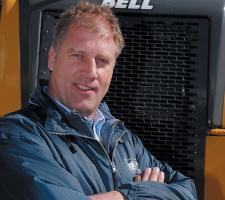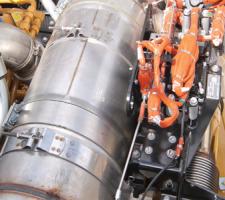
For equipment manufacturers changing to new emissions regulations there are two general routes as ABE reports
Quarry operators looking to buy new equipment this year may well come away from a dealer or an exhibition stand in some confusion.
The reason for this understandable bafflement is exhaust emissions, or possibly the lack of them.
Many will be familiar with the European Union’s Stage IIIB and US Tier 4 Interim emissions standards that affect most off-highway equipment, and manufacturers have been falling over each other to launch new kit equipped with these engines for some time now.
But things are not as simple as they may seem. While many of the new and updated machines that will appear at the Intermat exhibition in Paris (16-21 April) will boast Stage IIIB/Tier 4 Interim compliant engines: others will not.
There are a number of reasons for this, including upper and lower horsepower limits and something called the flexibility rules, which allows manufacturers to continue to fit machines with older engines that had already been built.
Equipment makers are in some cases using these flex rules to hold off the additional expense of the latest emissions-friendly installations as long as possible, to entice customers to their less expensive machinery. Others have decided that it will be easier simply to move straight to Stage IV/Tier 4 Final in 2014, so are holding out for those engines before making the change, rather than launch two different specifications in a couple of years.
For those that are making the change to Stage IIIB/Tier 4 Interim now there are two general routes to a cleaner exhaust system. The first is through the use of exhaust gas recirculation (EGR), which reburns a portion of the exhaust gas in combination with a diesel particulate filter (DPF) to clean up those gases that are passed from the engine.
The second option is selective catalytic reduction (SCR), where a urea-based additive fluid, usually called Diesel Exhaust Fluid (DEF) or AdBlue is injected into the exhaust system to assist with the catalytic reaction in the exhaust filter.
This is already a popular solution in some on-highway trucks and many, though by no means all, manufacturers believe that while EGR may be enough for Stage IIIB/Tier 4 Interim, almost all engine suppliers will have to move to SCR for Stage IV/Tier 4 Final, usually in combination with the EGR solution.
Emissions solutions
“We looked at various emissions solutions for Stage IIIB compliance but regeneration was a key consideration,” says Anders Larsson, executive vice president for technology at
“Essentially construction equipment spends much more time idling than trucks and as a result we opted for the DPF fitted with a burner to provide an on-the-fly regeneration solution, which doesn’t impact on machine performance even during the regeneration process. While urea (AdBlue) is reasonably accessible in Europe, the infrastructure really isn’t in place in North America. Suffice to say we certainly couldn’t manufacture different engines and after-treatment solutions for the two different markets.”
“Scania has experience with both SCR and EGR and strongly recommended SCR for the Doosan ADTs,” says European ADT sales and product manager Roy Haaker.
“Having a worldwide Scania service network available is also a good reason to choose Scania as our engine supplier.
“In addition, to meet Stage IV/Tier 4 Final in 2014 it seems that everybody will be using an SCR system, so it made the choice of SCR for Stage IIIB a natural choice,” says Jøran Søbstad, R&D manager at Doosan Moxy.
“Exhaustive research and testing has determined that an application-specific SCR system that is well integrated with our proven Interim Tier 4/Stage IIIB engine platform will be the best solution to achieve Final Tier 4/Stage IV emissions compliance,” says John Plasecki, John Deere’s director of worldwide marketing, sales and customer support.
However the company says that the fully integrated exhaust filter and SCR after-treatment components in its Integrated Emissions Control System will allow John Deere to use less AdBlue than some alternative solutions.
As one of the largest off-highway diesel engine suppliers,
The popular 6.7 litre QSB6.7 will use the Cummins Compact Catalyst-Selective Catalytic Reduction (CCC-SCR) after-treatment solution, while the larger QSX15 will have a Cummins Particulate Filter combined with SCR (CPF-SCR) solution.
“Cummins will be ready to meet the near-zero levels of emission regulations with the most productive engine range we have ever had available for our construction equipment customers,” says Bryden Clewlow, director for Cummins off-highway sales in Europe.
The good news for customers on site is that Cummins, among others, is promising increased efficiency and lower fuel consumption for these more highly regulated engines. Already the Stage IIIB engines are said to be up to 5% more fuel efficient than the base Stage IIIA engines.
With the addition of SCR for 2014, Cummins is promising a further 3% improvement.
German engine supplier
In common with many on-highway manufacturers, Deutz is achieving fuel savings through the use of more powerful, but smaller capacity engines.
It claims that its Stage IV engines will offer up to a 5% fuel saving compared to the Stage III installations.
However, while these emissions-compliant engines might save fuel there will be additional running costs for customers. In many cases service intervals will be unchanged although Stage IV/Tier 4 Interim engines will require high quality ultra-low sulphur fuels. Many will also insist on more expensive low ash engine oils.
Some DPFs will also require regular service work, as the accumulated soot will need to be burnt out of the filter. These filters may need to be removed to be serviced, or exchanged, at 3,000-4,500 hour intervals adding to maintenance costs.
While AdBlue is a relatively inexpensive fluid, it will need to be stored on site and distributed to machines correctly. Putting AdBlue into a diesel tank for instance will result in damage to the fuel injection system.
At present
Using SCR technology, the company says that tests run at its South African manufacturing facility show significant fuel savings on the new SCR Stage IIIB trucks versus the previous Bell Stage 3/Tier 3 engine trucks.
Managing director of Bell Equipment Europe, Marc Schürmann said: “The savings realised are similar through all the different class sizes of the Bell ADT with the tests showing that the SCR ADTs are up to 15% more fuel efficient than the Stage 3 predecessors.
“The complete design package of the Stage IIIB Bell ADTs enhances the fuel savings due to both the design of the Mercedes Benz SCR engine and because Bell ADTs are designed to be weight optimised.”
Bell Stage IIIB ADTs do not produce large amounts of PM, but do produce NOx gases, and to deal with this it is utilising the Mercedes Benz engine and after-treatment system, with this technology packaged as Bell Blu@dvantage.
“We are excited by the fuel efficiency test results because a possible 15% fuel saving will have a significant impact to the bottom line of our customers. Fuel is a large portion of the owning and operating cost of any earthmoving machinery with an estimated 40% of the owning and operating costs being allocated to fuel.
“Importantly it means that Bell Blu@dvantage will not only reduce the carbon footprint of our machines, but also achieve a possible 20% fuel advantage,” added Schürmann.
With such a variety of solutions and engines at different emissions standards, even from a single manufacturer, operating a mixed fleet of machinery is going to be something of a headache for a quarry operator.
A comprehensive understanding of exactly what is on site will be vital, to ensure that each machine gets the maintenance and the back-up that it requires.
What’s more, mistakes are going to be potentially very expensive to rectify. And once you get your head around that, it’s all going to change again in two years’ time.

















